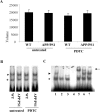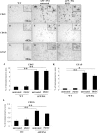Pyrrolidine dithiocarbamate activates Akt and improves spatial learning in APP/PS1 mice without affecting beta-amyloid burden
- PMID: 17409235
- PMCID: PMC6672417
- DOI: 10.1523/JNEUROSCI.0059-07.2007
Pyrrolidine dithiocarbamate activates Akt and improves spatial learning in APP/PS1 mice without affecting beta-amyloid burden
Abstract
Pyrrolidine dithiocarbamate (PDTC) is a clinically tolerated inhibitor of nuclear factor-kappaB (NF-kappaB), antioxidant and antiinflammatory agent, which provides protection in brain ischemia models. In neonatal hypoxia-ischemia model, PDTC activates Akt and reduces activation of glycogen synthase kinase 3beta (GSK-3beta). Because chronic inflammation, oxidative stress, and increased GSK-3beta activity are features of Alzheimer's disease (AD) pathology, we tested whether PDTC reduces brain pathology and improves cognitive function in a transgenic animal model of AD. A 7 month oral treatment with PDTC prevented the decline in cognition in AD mice without altering beta-amyloid burden or gliosis. Moreover, marked oxidative stress and activation of NF-kappaB were not part of the brain pathology. Instead, the phosphorylated form of GSK-3beta was decreased in the AD mouse brain, and PDTC treatment increased the phosphorylation of Akt and GSK-3beta. Also, PDTC treatment increased the copper concentration in the brain. In addition, PDTC rescued cultured hippocampal neurons from the toxicity of oligomeric Abeta and reduced tau phosphorylation in the hippocampus of AD mice. Finally, astrocytic glutamate transporter GLT-1, known to be regulated by Akt pathway, was decreased in the transgenic AD mice but upregulated back to the wild-type levels by PDTC treatment. Thus, PDTC may improve spatial learning in AD by interfering with Akt-GSK pathway both in neurons and astrocytes. Because PDTC is capable of transferring external Cu2+ into a cell, and, in turn, Cu2+ is able to activate Akt, we hypothesize that PDTC provides the beneficial effect in transgenic AD mice through Cu2+-activated Akt pathway.
Figures










Similar articles
-
Antioxidant pyrrolidine dithiocarbamate activates Akt-GSK signaling and is neuroprotective in neonatal hypoxia-ischemia.Free Radic Biol Med. 2006 May 15;40(10):1776-84. doi: 10.1016/j.freeradbiomed.2006.01.011. Epub 2006 Feb 9. Free Radic Biol Med. 2006. PMID: 16678015
-
Pyrrolidine dithiocarbamate activates the Nrf2 pathway in astrocytes.J Neuroinflammation. 2016 Feb 26;13:49. doi: 10.1186/s12974-016-0515-9. J Neuroinflammation. 2016. PMID: 26920699 Free PMC article.
-
Puerarin alleviates cognitive impairment and oxidative stress in APP/PS1 transgenic mice.Int J Neuropsychopharmacol. 2014 Apr;17(4):635-44. doi: 10.1017/S146114571300148X. Epub 2013 Dec 18. Int J Neuropsychopharmacol. 2014. PMID: 24345484
-
Tanshinone IIA regulates glycogen synthase kinase-3β-related signaling pathway and ameliorates memory impairment in APP/PS1 transgenic mice.Eur J Pharmacol. 2022 Mar 5;918:174772. doi: 10.1016/j.ejphar.2022.174772. Epub 2022 Jan 25. Eur J Pharmacol. 2022. PMID: 35090935
-
The role of metals in modulating metalloprotease activity in the AD brain.Eur Biophys J. 2008 Mar;37(3):315-21. doi: 10.1007/s00249-007-0244-1. Epub 2008 Feb 13. Eur Biophys J. 2008. PMID: 18270696 Review.
Cited by
-
Utilization of APPswe/PS1dE9 Transgenic Mice in Research of Alzheimer's Disease: Focus on Gene Therapy and Cell-Based Therapy Applications.Int J Alzheimers Dis. 2011;2011:517160. doi: 10.4061/2011/517160. Epub 2011 Oct 30. Int J Alzheimers Dis. 2011. PMID: 22114743 Free PMC article.
-
Maf1 loss regulates spinogenesis and attenuates cognitive impairment in Alzheimer's disease.Brain. 2024 Jun 3;147(6):2128-2143. doi: 10.1093/brain/awae015. Brain. 2024. PMID: 38226680 Free PMC article.
-
Abnormal Population Responses in the Somatosensory Cortex of Alzheimer's Disease Model Mice.Sci Rep. 2016 Apr 15;6:24560. doi: 10.1038/srep24560. Sci Rep. 2016. PMID: 27079783 Free PMC article.
-
Treatment with D3 removes amyloid deposits, reduces inflammation, and improves cognition in aged AβPP/PS1 double transgenic mice.J Alzheimers Dis. 2013;34(3):609-20. doi: 10.3233/JAD-121792. J Alzheimers Dis. 2013. PMID: 23271316 Free PMC article.
-
Glycogen synthase kinase-3β: a mediator of inflammation in Alzheimer's disease?Int J Alzheimers Dis. 2011;2011:129753. doi: 10.4061/2011/129753. Epub 2011 May 4. Int J Alzheimers Dis. 2011. PMID: 21629736 Free PMC article.
References
-
- Akiyama H, Barger S, Barnum S, Bradt B, Bauer J, Cole GM, Cooper NR, Eikelenboom P, Emmerling M, Fiebich BL, Finch CE, Frautschy S, Griffin WS, Hampel H, Hull M, Landreth G, Lue L, Mrak R, Mackenzie IR, McGeer PL, et al. Inflammation and Alzheimer's disease. Neurobiol Aging. 2000;21:383–421. - PMC - PubMed
-
- Bayer TA, Schafer S, Simons A, Kemmling A, Kamer T, Tepest R, Eckert A, Schussel K, Eikenberg O, Sturchler-Pierrat C, Abramowski D, Staufenbiel M, Multhaup G. Dietary Cu stabilizes brain superoxide dismutase 1 activity and reduces amyloid Abeta production in APP23 transgenic mice. Proc Natl Acad Sci USA. 2003;100:14187–14192. - PMC - PubMed
-
- Beach TG, Kuo YM, Spiegel K, Emmerling MR, Sue LI, Kokjohn K, Roher AE. The cholinergic deficit coincides with Abeta deposition at the earliest histopathologic stages of Alzheimer disease. J Neuropathol Exp Neurol. 2000;59:308–313. - PubMed
Publication types
MeSH terms
Substances
LinkOut - more resources
Full Text Sources
Molecular Biology Databases
